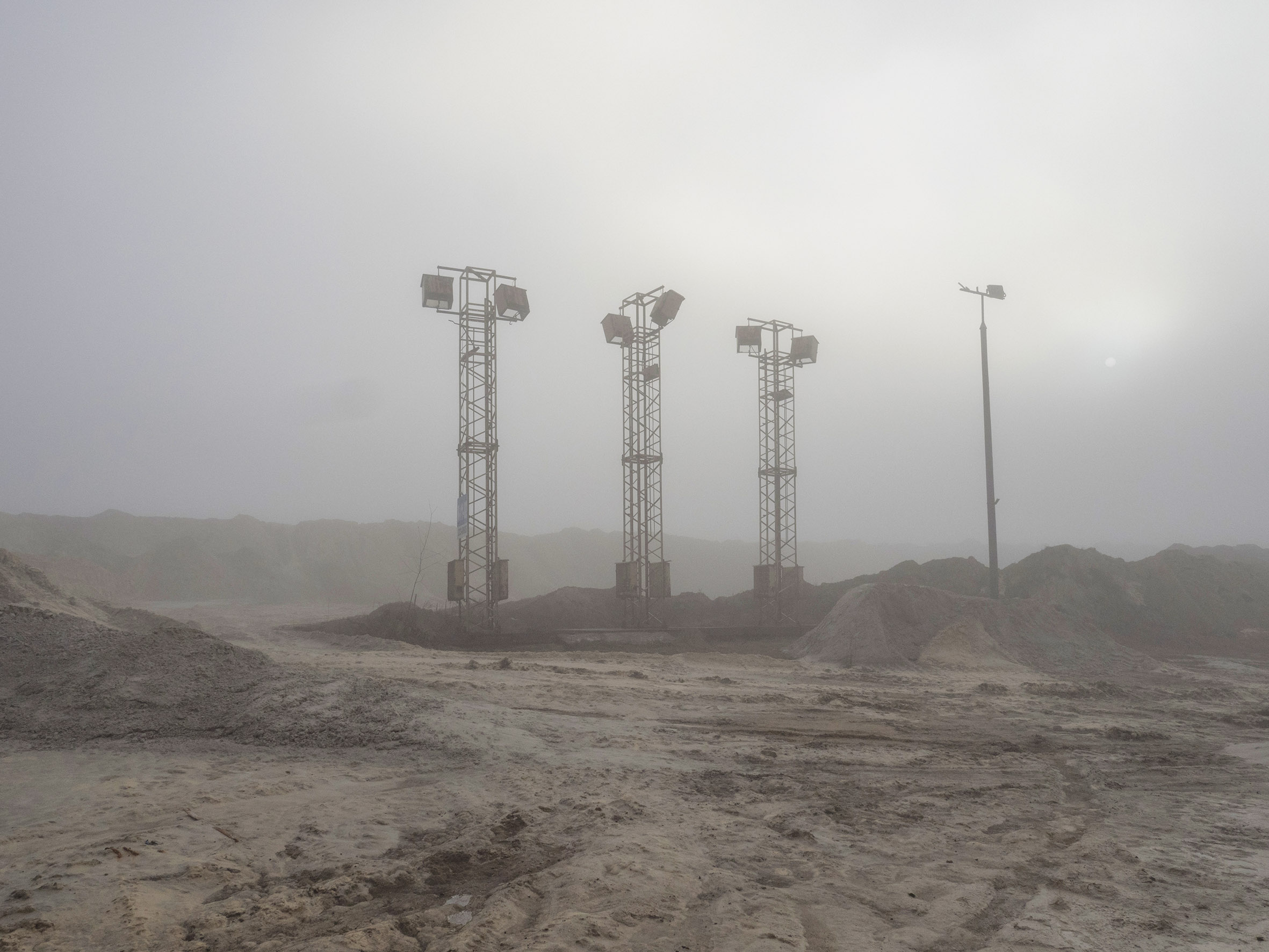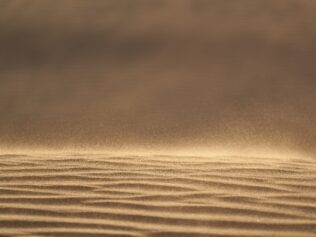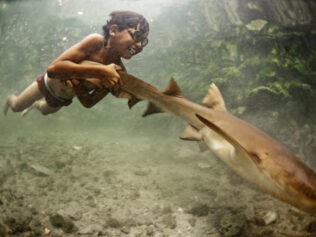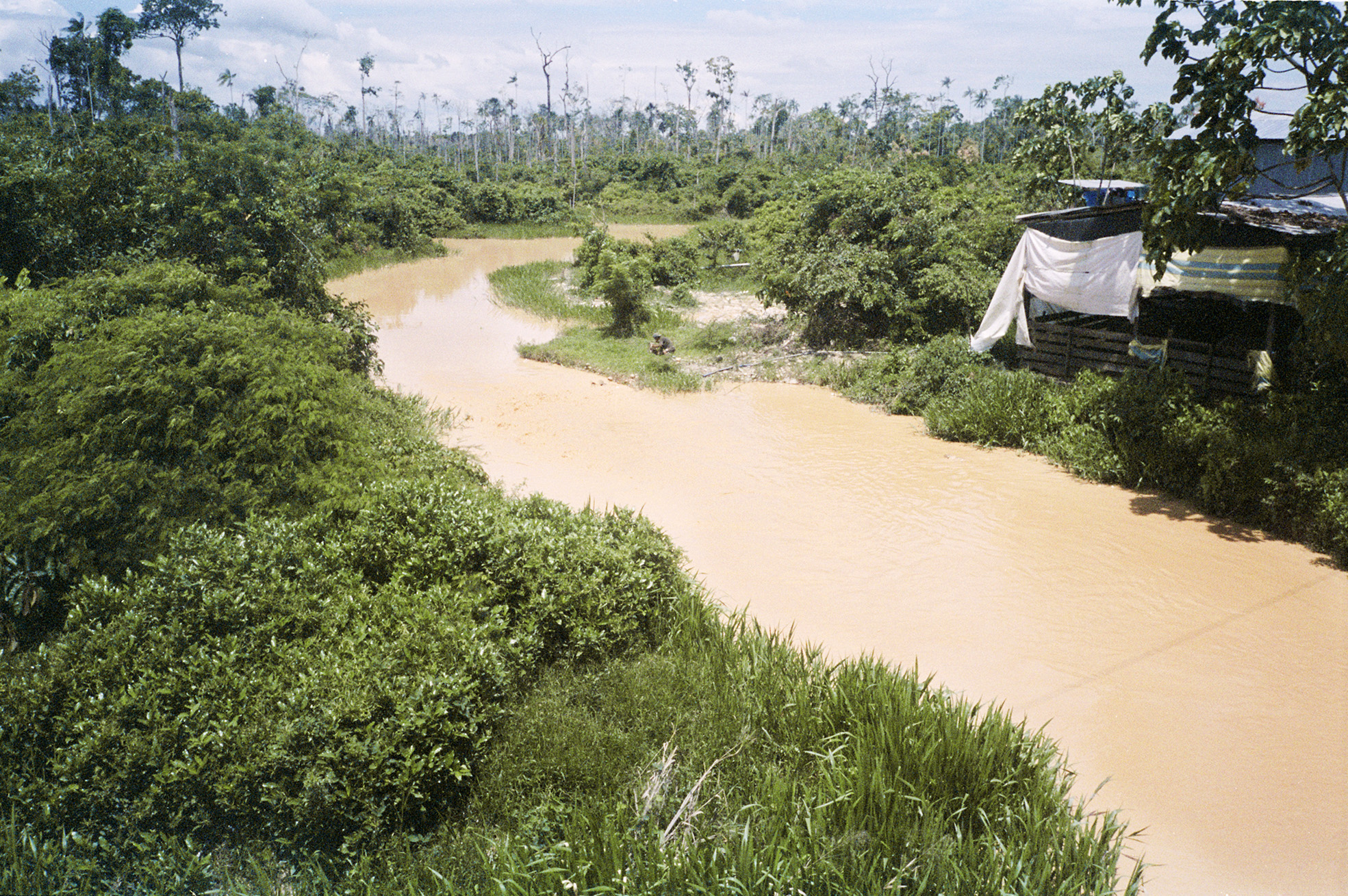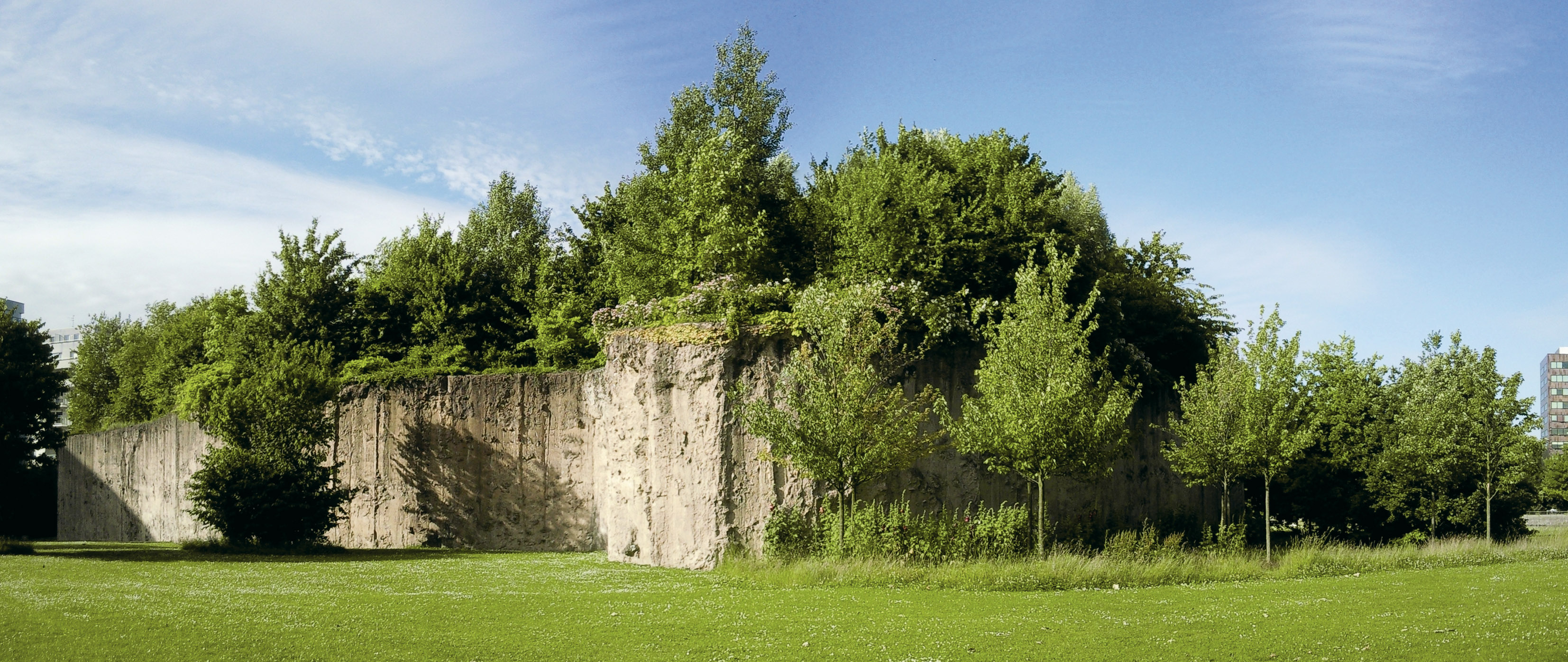
Whispers of the coming apocalypse lurk in the landscape of artificial mountains, lakes and rivers.
1
It feels more like decay than Armageddon. The village is called Kuźnica, a collection of several dozen houses on the edge of the open pit. I make my way along a drainage ditch. The concrete sides are covered with a rusty residue; the water pumped out of the mine has a lot of iron in it.
It’s quiet here. Only after a few minutes do I realize – it’s a little too quiet.
Somewhere in the distance a dog is barking, but here there is silence. I start to look around carefully, peering over garden fences. The yards are clean and tidy. Empty. No one lives here. You can tell from the weeds that have already taken over.
I stand in one of the empty yards and only then do I begin to understand. The houses on this side of the village were abandoned because the fields that belonged to them were swallowed up by the pit. They were a covering layer that was removed. I look at the empty house, the open barn door, through which I can see the desert-like landscape of the pit, and I feel the growing suction of a vacuum.
2
On 9th December 1961, employees of the Piła Oil Exploration Company discovered a deposit of tertiary era lignite in a village near Bełchatów called Piaski, which no longer exists. This is where it all started. Further sampling proved unusually promising. The deposit guaranteed a good supply of this raw material for decades to come. To get access, several villages had to be liquidated. The largest of them, Kuców, had 116 families; Folwark had 88 and Wola Grzymalina had 84. Add to this Antoniówka, Kocielizna, Kociniak, Modrzewiec, Stawek and Gadka. And the settlement of Wiktoria with just one family. I try to imagine how they came to tell them. Maybe it was early autumn, the mists rolling over the fields. Some way off, deep in the landscape, the cranes were honking. The settlement of Wiktoria. The growl of an engine, slamming of doors, a barking dog. “You’ll have to leave this place.” “And where will we go?” “Over there, beyond the field. We’ll help. There’ll be compensation. This is going to be a mine. Why would you want to sit out here in this village? Go to the city. They’re building apartment blocks there.”
Doors again, the engine, dog, cranes. Silence.
Then they had to reroute the river, digging a 250-metre deep hole in its place, making a mountain nearly 400-metres high with the spoil.
It started with the river. The Widawka. The valley had been inhabited since the times of the Lusatian culture (from Biskupin, 700–400 BC). On 1st March 1975, they began to dig an alternative course for the river. Compared to what was to come, moving it was no great challenge. They finished at the end of July the same year.
3
The holiday camp in Wawrzkowiźna is empty and quiet. It was built for the miners and employees of the power plant as a ‘recreation centre’. A random car is parked by the administration building. Last year’s leaves litter the swimming pool. Everywhere you turn are large signs banning the riding of quad bikes and motorbikes. Clearly they’re everywhere in the summer.
I wander about for a while between the Brda houses and then head towards the pseudo river. I cross a waterlogged volleyball court and pick up the path into the forest. The reservoir is half frozen and a little flock of mallard ducks huddles at the edge of the ice. On the other bank, a great white egret takes flight. For a moment, its outline looks like the glint off a mirror onto the black wall of the forest. The egret circles round and lands back in the same place.
Further out is a reed bed; the path skirts round it. Beyond this, a schizophrenic space opens up. This is why I came here. When I looked at the map, I knew instantly that I had to see it. The Widawka flows along an artificial riverbed here; not so much a riverbed as a wide, concrete culvert. Apart from a gentle bend in one place, it flows straight as a draughtsman’s ruler. The path runs along the northern bank, squeezed in between the artificial course and the old river bed that they didn’t bother to fill in. And so, I make my way along, with the artificial river to my right and its overgrown afterimage to my left. Every so often I come across the evidence of beaver works lying across the path. Some are fresh, still smelling of woodchips. The tracks and traces leave no illusions. The beavers come here from the old river bed just to stuff themselves. They make a big mess and return home. Dropping trees over this pseudo-river is completely out of the question. It looks as though they understand that it wouldn’t be worth their time or energy.
Further on is road Nr 484 and an underpass. The construction works of a dam on the Słok reservoir loom in the distance.
I stand on an old bridge and look around. A building with a brick ground floor and wooden raised roof draws my attention. It stands a few dozen metres back from the river, between the trees. I stare at it for a long time, because it reminds me of something.
“It’s a mill,” I hear from behind me. The man is maybe 50 years old. He was riding a bike and had been forced to stop because I had had this absent-minded moment right in the middle of the path.
“A mill?” I ask.
“Yeah, a mill,” he replies. “You can even see the mill sleeve. Over there.”
“A mill,” I repeat mechanically. “But where’s the river?”
Because if there is a mill, something must power it. And this one is standing on a water meadow.
The man gives me an indulgent look. Slightly as if he wanted to give me a little more time to think. And then I get it – the bridge, the road, the river made of prefab concrete, moved from its old course, which has now been overgrown by this meadow.
Hence the mill – orphaned by the river.
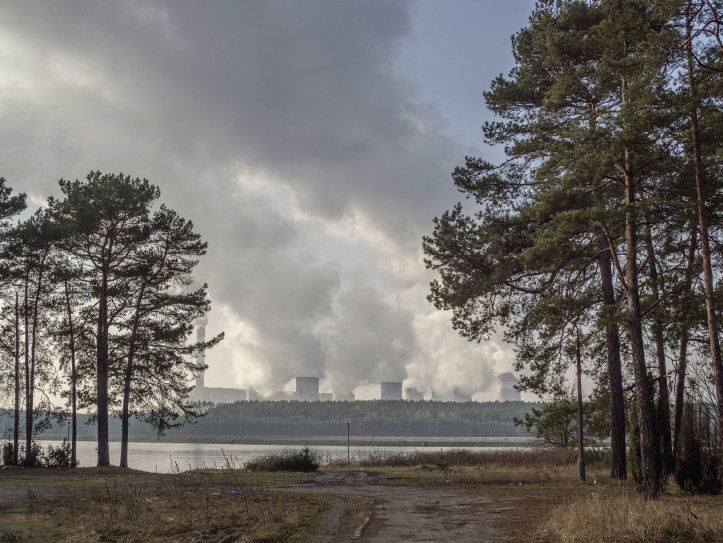
4
The first bones came out of the ground in the early 1980s. The machine was stopped and the experts called in. Mammuthus primigenius – a woolly mammoth. The first few fragments still caused a sensation. It was all over the newspapers. Later, as successive bones emerged, there was less excitement. But mammoth bones were dug up here regularly, every few years.
In 2003, a digger scoop split a whole skull. Nine years later they found a jawbone with two molars, a rib, the left socket of a pelvis with a fragment of hip bone and a piece of pubic bone.
In articles about that last find they wrote that mammoths died out as a result of “large-scale climate change”. Here, near to today’s Szczerców, it looked as though the receding glacier stopped the water running off. A huge lake was formed, fed by the melting glacier. These waters brought a multitude of sands, sediments and clays, which settled at the bottom. That’s how this plain was created – the water eventually seeped away and the sediment remained. Round its edges the wind whipped up sandy dunes and pine trees grew on them. Nearby hollows filled with water spawned the peat deposits.
That’s how a real landscape is made. It takes several thousand years.
Or take the settlement studied by archaeologists in Chabielice. This was before the time of the Szczerców open pit. A sentence from the end of the scientific study reads as follows: “The settlement was probably abandoned deliberately due to soil degradation or the exhaustion of the limestone quarry.”
So what? So nothing. Don’t waste your breath.
5
I walked around the edge of the pit to learn something about the future. I wanted to be overwhelmed by the scale of the site where not just an individual but even a gigantic machine is insignificant. Both are equal here – they die in the infiniteness that casts its shadow over time. Suddenly the whole history of civilization seems like the blink of an eye. There is a timeline of geological layering, stretching back over many millions of years, and then there is us with our fears of tomorrow. Well, there won’t be any tomorrow, and this very thought is just a speck of dust on the surface of history.
Yes, somewhere here begins the apocalypse that we will most probably take part in; we, our children and grandchildren. You can read it already in the landscape. You just have to look carefully (and listen – of which more in a moment). The landscape is dominated by the chimneys of the Bełchatów power plant, the greatest polluter in Poland and Europe. One reasonably long look – let’s say five seconds – and six tonnes of CO2 spews into the atmosphere (as well as nitrogen oxide, sulphur and mercury). It’s too terrifying to look any longer.
But closing one’s eyes doesn’t change anything.
Kleszczów – the borough where the mine is located – is the richest in Poland. And it shows. Everything here is new, almost new or recently renovated. There is nothing left to spend their taxes on. They spend whatever they can on colourful pavements, village halls, playgrounds, council buildings, storehouses and parish buildings. Their cultural centre looks like it took part in the competition to be included in the Polish pavilion at Expo.
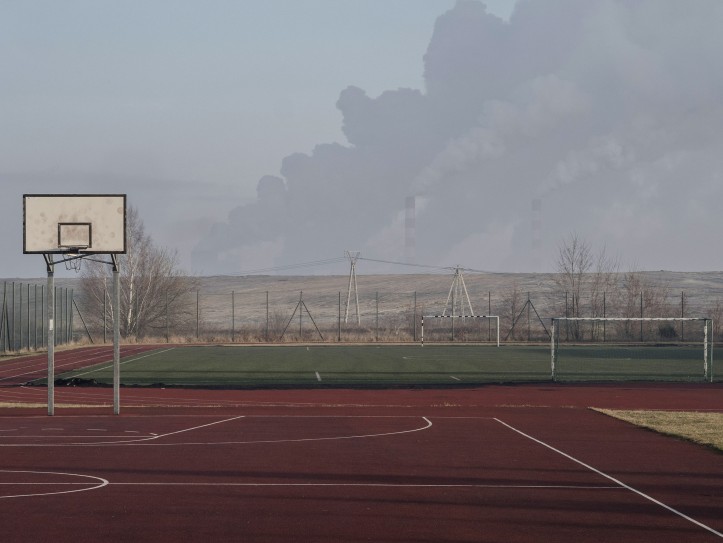
I drive on through this wealth and imagine what it will look like when it all ends. These wide roads, extensive roundabouts like at an airport, and avenues bordered by wrought iron filigree railings. Roasted by the heat from the overheated planet where all life has already died out; when we are no longer here because we boiled ourselves in our own bodies or ripped each other’s throats out.
I drive through this parish, the richest in Poland, sculpted to within an inch of its life, to the edge of the empty eye socket in the earth, which exudes evil, and I wonder what it will be like when it’s over; one day, at dusk like today, but without the LED glow that floods everything with its cold light, even the most out of the way paths.
6
And all this in the flat shade of the artificial Kamieńsk mountain. You won’t see anything higher than this for dozens of kilometres around. 400 proud metres above the ever-rising sea level. And as if this is not enough, the face of this hill has been powdered with real Alpine make-up. There’s a ski lift, ski runs, a mountain rescue team with snowmobiles and a handful of shops selling ski gear. A skier lounges on a deckchair by the lower station. He’s wearing sunglasses and has a suntan that is suspiciously deep for the powers of the Bełchatów skies. He proudly holds a tankard of beer in his hand. Maybe he shuts his eyes and conjures up images of St. Moritz? That would be more sensible. With a little goodwill, for a moment one might forget that we are in fact on the outer slopes of the slag heap of an open cast lignite mine.
7
But it’s not just about these novelties. The whole area is full of ersatz landscapes. Man has replaced nature here, moved rivers, built himself a mountain, planted a forest. It all took four decades. How does one handle a landscape that was made in such a short time?
When the pits are flooded, it will create one of the largest lakes in this part of Poland. A shard of our greed; an attempt to cover up our crime with a landscape. What to call it? A superlandscape? A landsuperscape? A hyperlandscape? A superimposed landscape? Uberlandszaft?
8
A dyke runs through the middle of the Słok reservoir. It means effectively that there are two bodies of water. From the eastern bank, you can see the power station. A cloud emerges from it and covers the whole area in shadow. I understood this for the first time yesterday, when I got here. It was a sunny day and suddenly it became dark and gloomy. I looked up at the sky and saw one enormous cloud several kilometres across. It hung right over me and I tracked along its edge with my eyes. It was coming from the power station.
So even the clouds here are artificial.
And now, I walk along the eastern bank of the Słok reservoir. Along the way, I pass other buildings that are, in fact, the ruins of holiday camps. In some camps, one or two buildings are still standing, in others there are overgrown paths or foundations being swallowed up by the earth. It looks as though the apocalypse already happened here; as if the final blast had wiped out everything transient, leaving behind only the sturdiest geological materials.
Maybe that’s what it will be like.
So I carry on and think about the pride hidden in these ruins. Because someone here once took the decision to fill this reservoir bank with holidaymakers, thinking they would want to sunbathe here with a view of this cloud factory. Yet for some reason they didn’t want to.
At the Wodnik Hotel, the only one open in the area, they are getting ready for a conference. The waitresses are scurrying about, shaking open folding chairs. In the restaurant, with its view over the lake, one entire wall is covered with a scene from a tropical island. They conjure me up a pork chop from somewhere and I look, in turn, out of the window and back at the wall. I start to feel very confused.
I become increasingly uncertain of what is really artificial and what is artificially real.
9
Only after a few days do I realize that this whole area would be an ideal setting for planning a crime novel. The half-deserted villages, wide roads with almost no traffic, the wealth that only a handful of people benefit from. Moustachioed men in muddy boots, the gloom of the power station, the apocalyptic cloud factory and check-points on the roads (“Please open the boot.”). And everywhere, their green Land Rovers. It’s easy to tell oneself that its environmental protection: they are on the trail of something; they’ve found it and now they won’t let it go. They appear suddenly, from side roads and dirt tracks – roads that only they are allowed to use – and then they putter on with that distinctive, diesel-engine sound. Because who would give a fuck… about some retail environmental protection in the very heart of its wholesale destruction?
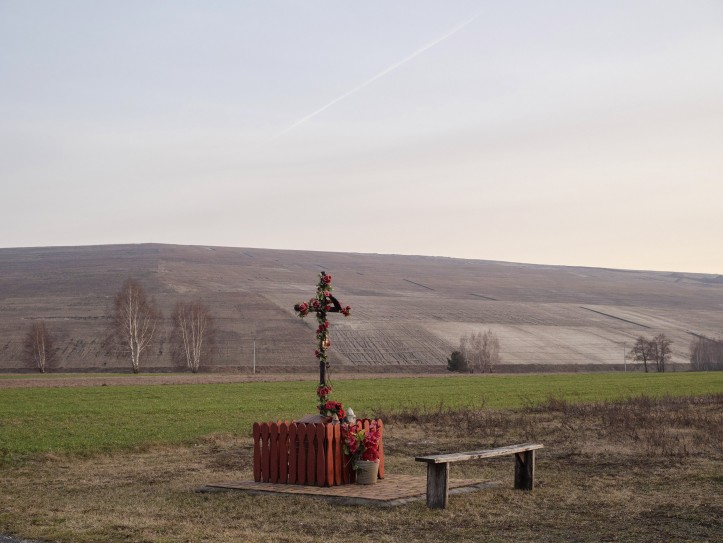
The drivers of the vehicles look like officers of the Agency for the Implementation of Ragnarok. There’s no doubt that they take their duties very seriously. They have unlimited resources and merciless technology at their disposal. It might not be the most advanced technology, but nobody ever said that finesse would be required for the end of civilization. No, no such things; all that’s needed is blunt, brute force, determination and well-coordinated actions. These green jeeps, which are everywhere on the roads round the pit, look like the neurons of a suicidal brain.
10
We leave before dawn. Rasmus, the Danish photographer who asked me to show him the place, wants to take a photo of the chimneys from across the lake. But the mist is so thick that we don’t even stop. We pass the power station, and the man in the checkpoint just waves and lifts the barrier. We head towards Złoczew. This is where the next pit is due to be dug. It’ll eat up 33 villages; 3000 people will have to move. Again, that counting rhyme.
To get to the coal, they will have to move another river – the Oleśnica.
The mayor of Złoczew told the press that he had talked to the residents and that the majority of them are in favour of the pit. They believe it will “kickstart development”. Land prices have already started to rise, particularly for building plots.
We are driving through sleepy villages. After almost an hour the satnav starts to beep. We’ll reach Dąbrowa Miętka very soon. This will be the first village to disappear. I ask Rasmus to stop the car. I get out. The road ahead disappears into the mist, as do the fields of clay on either side. Rasmus gets out as well. He leans on the bonnet and listens intently.
“Not a sound, huh?”
Indeed, there is almost complete silence around us. One could even get the impression that it’s down to the mist; that it isolates us from any sounds. And just as I start to believe this really might be true, somewhere ahead of us, from one side of the condemned village, the sound of a barking dog reaches us. We listen to it, mesmerized. The mist, the dog, and the apocalypse that is about to take place here. How many have there already been? In the end, we’ll get the last one.
11
Uberlandszaft gives us a window onto the future, a visualization of what is going to happen. It allows us a taste of the impending catastrophe. In the tension between its elements – the fake river, the fake mountain, the fake forest, fake lake – the horror of the impending downfall lies dormant.
Its murmur is becoming more insistent.
Thus far, only a few people can sense it in the nauseating, ultra-low-frequency infrasound, but very soon it will hit us all with its low, earthbound growl.
Translated by Annie Krasińska


